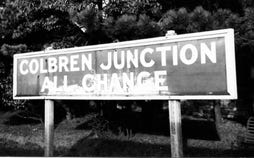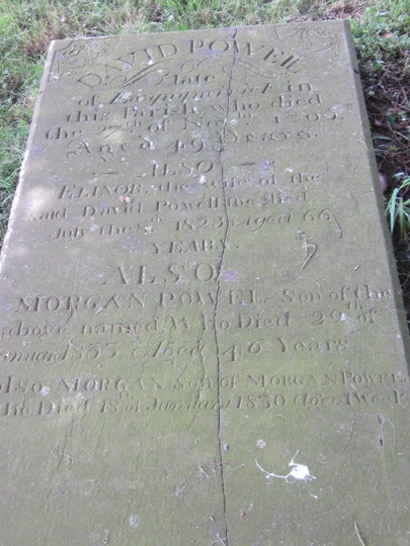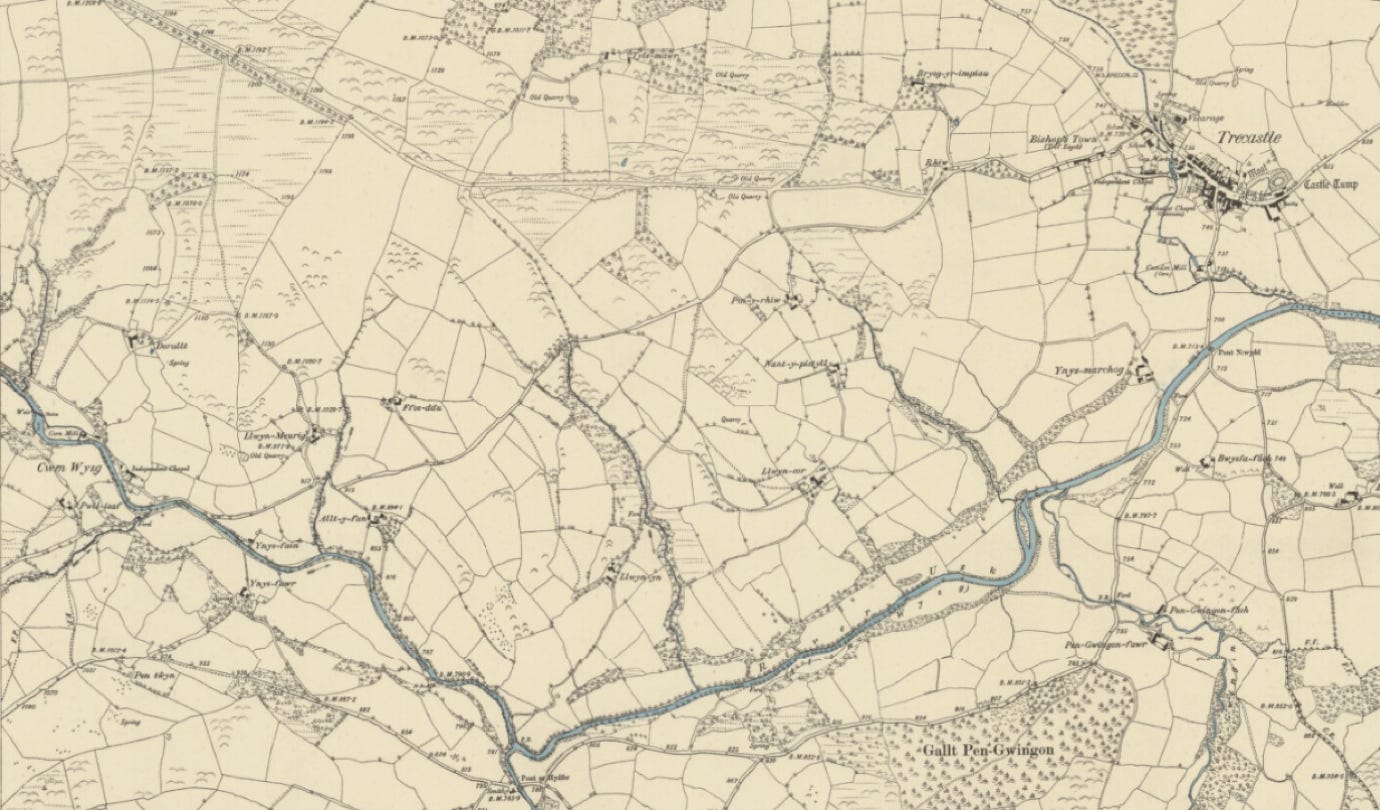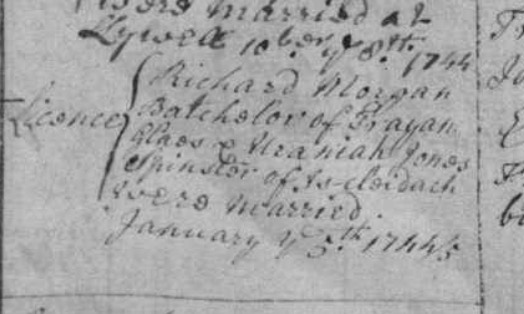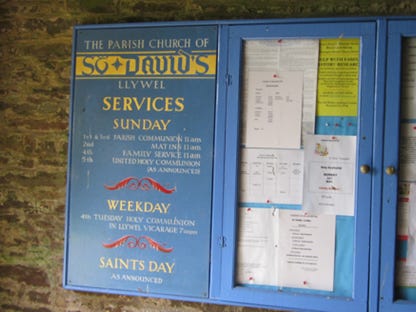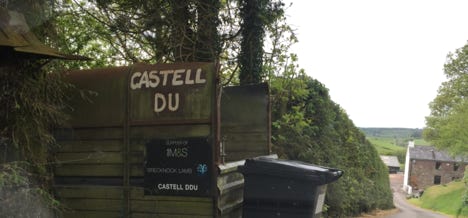We now travel north to the rural Welsh hinterland bordering Breconshire and Carmarthenshire. While only about 15 miles away, it was and still is a completely different environment to the now rapidly industrialising Dulais Valley area to which our Morgan family would become connected. It feels a lot further away. North of Penycae there is nothing but the seemingly endless high moor and the stony, lonely Crai reservoir, ghosts of how many farmers resonate, before dropping down into Defynnog and the altogether gentler beginnings of the less threatening part of rural Breconshire, at least here in the valley. North of this, of course, start the Brecon Beacons proper, a mountainous landscape, through which our ancestors seem only to have travelled. Our Morgans came from around the villages of Llywel and Trecastle, on today’s A40 between Brecon and Llandovery. This was a key and ancient communications and trading axis between England and west Wales, the old London to Fishguard road, particularly important for centuries as a cattle-droving route, so was not completely in the backwaters and in many ways was better connected to the outside world than our more industrially advanced but still rather remote and inaccessible wild upland of Banwen Pyrddin. In those days, Llywel parish was large and extended about 20 miles in each direction, no doubt because of the sparse population: in 1849 it was estimated at only 1,684 inhabitants (“St David’s Church Llywel, an Illustrated Guide”, R Camp). Until recent times, Llywel Parish was generally split into the following divisions:
- Llywel village
- Trecastle
- Traian, Trian or Trayan Glas
- Traian, Trian or Trayan Mawr
The last two are sometimes referred to as hamlets but they do not appear to be nucleated settlements, rather collections of scattered farms. A parish church - St Mary’s - was established for Trayanglas and that and its vicarage provide something of a focal point. The vast majority of our Morgans are recorded in either Trayan Glas or Mawr, since the earliest records available.
Some of the earliest entries are hard to read, though, so we catch only tantalising glimpses sometimes of possible forebears: “Lewis Morgan de [of] Trayan Glas, yeoman…1696”; “Margaret, the wife of David Morgan, yeoman, Trayan Glas was buried April the 17th Anno Domini 1697”; “Richard the son of Llwelyn John Morgan yeoman de [of] Trayan Mawr was baptised April the 9th 1698”…
The curate or the vicar writing in the book gave men, and by implication their families, a place in the social hierarchy of the time, which we can reconstruct as generally being:
Pauper (or beggar)
Labourer (in this area, agricultural)
Tradesman (or Farmer): Shoemaker, Miller, Cobbler, Carrier, Tailor all feature for the Morgans
Yeoman, of which there are some Morgans
Gent [leman] – a couple found so far
Women, on the other hand, were given little positive status other than daughters or wives, but plenty of negative labels abound: “concubine” features heavily in the earlier records. Pity poor “Sarah, bastard child of Mary Davis Andrew and the reputed daughter of Jenkin Morgan…” In 1709, we can feel the full force of the vicar’s disapproval, still fresh after three hundred years, as he records “David a bastard child of Owen Thomas which he begot upon the body of Janet verch [daughter] of Watkin Morgan flaxman de [of] Trayan Mawr.” At least here he gave the father equally short shrift: plenty of children appear innocently in the register with only a father’s name; they tended much more to get the “bastard” label when there was only a mother’s name…
This Ordnance Survey six-inch to the mile map of 1885 shows many of the Morgan settlements in the Trayanglas area, generally ranging southwest of Trecastle along the course of the young river Usk. The village of Trecastle is on today’s A40.
The first family of interest to us in this area came from the farm of Castell Ddu just off this map, to the west of the small hamlet of Cwm Wysg.
This is the earliest Morgan gravestone so far found. It lies in the churchyard of Llywel Parish Church and commemorates David Powell (1756-1805), who had married Elinor Morgan of Castell Ddu (1759-1823).
Elinor Morgan was a daughter of Richard Morgan (1715-1800), of Castell Ddu farm, Traianglas, a few miles southwest of Trecastle in the Cwmwysg area. He and his wife Urania (Jones) are recorded at various times here in the eighteenth century. This is the northern side of the Black Mountain, very near the source of the river Usk and this scattering of hill farms near today’s Usk Reservoir appears to form the cradle for our Morgan families in this area, since earliest records. Richard and Uraniah married at Llywel in 1744 and Castell-ddu is the earliest-recorded settlement we can so far find for our particular branch of the Morgans. The farm still exists today and appears to be a successful sheep-rearing enterprise, and lamb supplier.
Extract of Llywel Parish records: marriage of Richard Morgan and Uraniah Jones, 5 January 1744
At some point in the mid eighteenth century, the couple moved to Gellfain, in the Trayanmawr locality. An entry in the Llywel parish Register states that, “Urania the wife of Richard Morgan of Gellfain in Trayan Mawr was buried January 16th 1777”.
Richard and Urania Morgan had at least seven children, some of whom were equally prolific and thus we see a snapshot of a very large family indeed. Various branches of Morgan and Morgans - the two variants seem to be interchangeable with little or no discernable logic - form a dense patchwork of families in the Llywel area. It is beyond the scope of this work to consider them all so we will focus on the direct line of interest to our Coelbren family.
